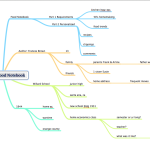Today’s column at Shades of the Departed, “Raiders of the Lost Arc[hive]” by archivist Rebecca Fenning, is a wake-up call to all Family Curators. Who ever guessed at the untold, unprocessed treasures hidden in the depths of our favorite repositories? It is both frustrating and depressing to read that hundreds, if not thousands and tens of thousands, of documents are unavailable to researchers for lack of processing.
This rather sounds like my own “archive” of family papers. When I began organizing my grandmother’s letters and miscellaneous papers, I felt the call to do things right. In so doing, I fell into the very archival abyss described by Mark A. Greene and Dennis Meissner in their report, “More Product, Less Paper.” As Greene and Meissner describe it, archivists routinely process a collection by item-level handling, whether or not the collection warrants such minute attention. And, just like the good little archivist I longed to be, I foldered and refoldered every item and removed every piece of metal I encountered. And at the end of the summer, I too had only “processed” a fraction of the collection.
In fact, I should not be suprised. According to Greene and Meissner, an email survey of archivists estimated that it should require 14.8 hours per cubic foot to process 20th century material. I figure that I have a trunk-full of stuff, about 16 cubic feet; so it should take me about 236.8 hours or 29.6 days to organize it. That would be, of course, if I was experienced and knew what I was doing, which I am not.
And, if those figures aren’t depressing enough… compare this to the time archivists actually spent processing similar materials — “the modal average — the most frequent value in the range — was 33 hours per foot.” It’s no wonder I didn’t make much headway.
While Rebecca’s article for Shades is a heads-up for researchers to remember those hidden collections, I think she is also making a point which can help Family Curators work with their own material. We need to think about how we will use a collection, and preserve and process with that goal in mind. This might mean moving forward even if we don’t have funds for expensive archival storage boxes, but it also means asking good questions if we donate our collection to a repository such as a library or museum so our treasures aren’t forgotten in the back room of an archive.






Your tips for donating to archives are great, Rebecca. I am sure that being involved at an archive will be a big help in keeping collections alive.
It is sad to think of all that “stuff” languishing somewhere. I hope more archives adopt those MPLP practices and move things out in front for researchers. Thank for informing us about the situation!
Thanks for the thoughtful response to my column, Denise. You make some really great points about applying those More Product, Less Process concepts to personal archives — and I totally agree. I could definitely use Greene & Meissner's advice when it comes to my own family papers, even though I try to apply it all the time at work (oops!)
As far as donations to institutions go, it is definitely important to enquire about the backlog and when you might expect your donation to be processed. A monetary donation to help with things like archival boxes & folders or even storage costs can go a long way to making sure your collection is processed more quickly, for it is often for lack of things like this that collections get processed slowly. Being an active donor can help too — every time you send a holiday card or volunteer at an event, it reminds the archivist to move your collection up the priority list!